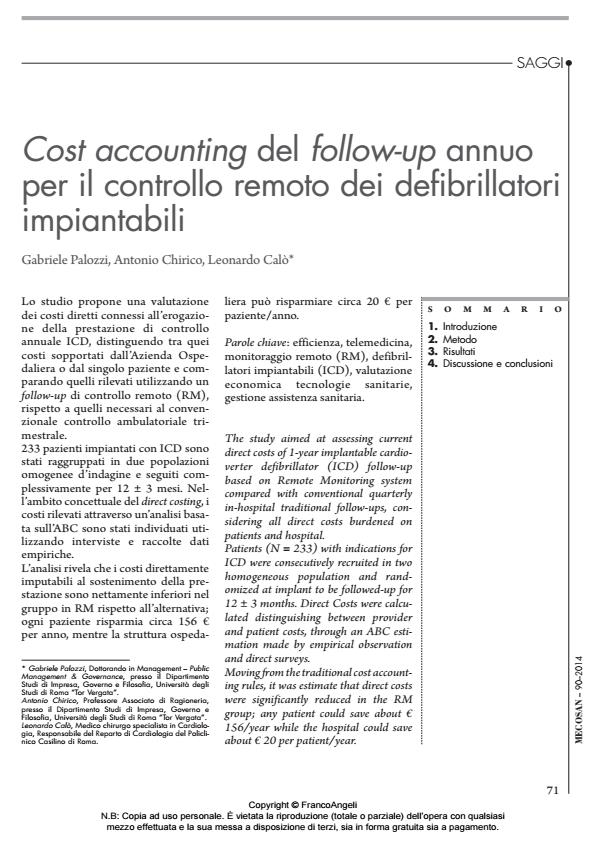Cost accounting del follow-up annuo per il controllo remoto dei defibrillatori impiantabili
Titolo Rivista MECOSAN
Autori/Curatori Gabriele Palozzi, Antonio Chirico, Leonardo Calò
Anno di pubblicazione 2014 Fascicolo 2014/90
Lingua Italiano Numero pagine 28 P. 71-98 Dimensione file 477 KB
DOI 10.3280/MESA2014-090005
Il DOI è il codice a barre della proprietà intellettuale: per saperne di più
clicca qui
Qui sotto puoi vedere in anteprima la prima pagina di questo articolo.
Se questo articolo ti interessa, lo puoi acquistare (e scaricare in formato pdf) seguendo le facili indicazioni per acquistare il download credit. Acquista Download Credits per scaricare questo Articolo in formato PDF

FrancoAngeli è membro della Publishers International Linking Association, Inc (PILA)associazione indipendente e non profit per facilitare (attraverso i servizi tecnologici implementati da CrossRef.org) l’accesso degli studiosi ai contenuti digitali nelle pubblicazioni professionali e scientifiche
Lo studio propone una valutazione dei costi diretti connessi all’erogazione della prestazione di controllo annuale ICD, distinguendo tra quei costi sopportati dall’Azienda Ospedaliera o dal singolo paziente e comparando quelli rilevati utilizzando un follow-up di controllo remoto (RM), rispetto a quelli necessari al convenzionale controllo ambulatoriale trimestrale. 233 pazienti impiantati con ICD sono stati raggruppati in due popolazioni omogenee d’indagine e seguiti complessivamente per 12 ± 3 mesi. Nell’ambito concettuale del direct costing, i costi rilevati attraverso un’analisi basata sull’ABC sono stati individuati utilizzando interviste e raccolte dati empiriche. L’analisi rivela che i costi direttamente imputabili al sostenimento della prestazione sono nettamente inferiori nel gruppo in RM rispetto all’alternativa; ogni paziente risparmia circa 156 € per anno, mentre la struttura ospedaliera può risparmiare circa 20 € per paziente/anno.
Parole chiave:Efficienza, telemedicina, monitoraggio remoto (RM), defibrillatori impiantabili (ICD), valutazione economica tecnologie sanitarie, gestione assistenza sanitaria.
- L'introduzione di un sistema di prezzi di trasferimento. Il caso dell'Azienda Ospedaliero-Universitaria Pisana Luca Del Bene, Antonello De Vito, Carlo Milli, Fabio Guarracino, in MANAGEMENT CONTROL 2/2018 pp.35
DOI: 10.3280/MACO2018-002003
Gabriele Palozzi, Antonio Chirico, Leonardo Calò, Cost accounting del follow-up annuo per il controllo remoto dei defibrillatori impiantabili in "MECOSAN" 90/2014, pp 71-98, DOI: 10.3280/MESA2014-090005